Complete Solutions to SECTION- B of chapter MATHEMATICS- 2015 of Class 10 book with complete answers and questions
| Class 10 | MATHS |
| Chapter | MATHEMATICS- 2015 |
| GURUKUL PUBLICATION | SECTION- B |
| Number Of Questions | 36 |
| Academic Year | 2023-24 |
Use a graph paper for this question take 1 cm = 1 unit along both the X and Y axis :
(i) Plot the points A(0, 5), B(2, 5), C(5, 2), D(5, -2), E(2, -5) and F(0, -5).
View SolutionUse a graph paper for this question taking 1 cm = 1 unit along both the x and y axis:
(i) Plot the points A(0, 5), B(2, 5), C(5, 2), D(5, -2), E(2,-5) and F(0, -5).
(ii) Reflect the points B, C, D and E on the y-axis and name them respectively as B', C', D' and E'.
View SolutionUse a graph paper for this question taking 1 cm = 1 unit along both the x and y axis:
(i) Plot the points A(0, 5), B(2, 5), C(5, 2), D(5, -2), E(2,-5) and F(0, -5).
(ii) Reflect the points B, C, D and E on the y-axis and name them respectively as B', C', D' and E'.
(iii) Write the coordinates of B', C', D' and E'.
View SolutionUse a graph paper for this question taking 1 cm = 1 unit along both the x and y axis:
(i) Plot the points A(0, 5), B(2, 5), C(5, 2), D(5, -2), E(2,-5) and F(0, -5).
(ii) Reflect the points B, C, D and E on the y-axis and name them respectively as B', C', D' and E'.
(iii) Write the coordinates of B', C', D' and E'.
(iv) Name the figure formed by BC DEE'D'C'B'.
View SolutionUse a graph paper for this question taking 1 cm = 1 unit along both the x and y axis:
(i) Plot the points A(0, 5), B(2, 5), C(5, 2), D(5, -2), E(2,-5) and F(0, -5).
(ii) Reflect the points B, C, D and E on the y-axis and name them respectively as B', C', D' and E'.
(iii) Write the coordinates of B', C', D' and E'.
(iv) Name the figure formed by BC DEE'D'C'B'.
(v) Name a line of symmetry for the figure formed.
View SolutionVirat opened a Saving Bank account in a bank on `16^(th)` April, 2010. His pass book shows the following enteries.
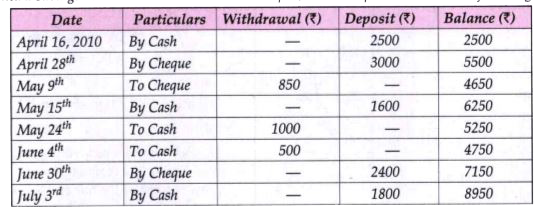
Calculate the interest Virat earned at the end of `31^(st)` July, 2010 at 4% per annum interest. What sum of money will he receive if he closes the account on `1^(st)` August, 2010 ?
View SolutionIf a, b, c are in continued proportion, prove that
`(a+b+c)(a-b+c)=a^(2)+b^(2)+c^(2)`.
View SolutionIn the given figure ABC is a triangle and BC is parallel to the Y-axis. AB and AC intersects the y-axis at Pand Q respectively.
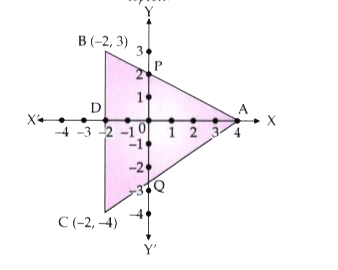
(i) Write the coordinates of A.
View SolutionIn the figure, given, ABC is a triangle and BC is parallel to the y-axis. AB and AC intersect the y-axis at P and Q respectively.
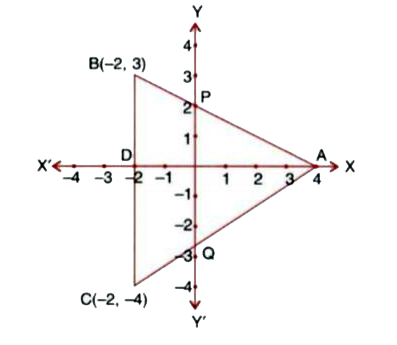
Find the length of AB and AC.
View SolutionIn the given figure ABC is a triangle and BC is parallel to the Y-axis. AB and AC intersects the y-axis at Pand Q respectively.
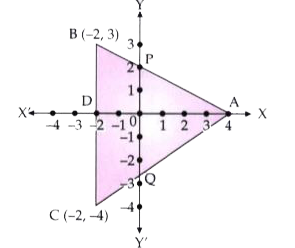
(iii) Find the ratio in which Q divides AC.
View SolutionIn the given figure ABC is a triangle and BC is parallel to the Y-axis. AB and AC intersects the y-axis at Pand Q respectively.
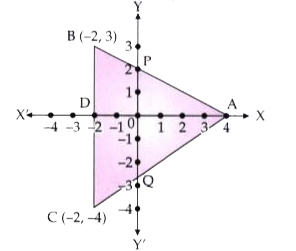
(iv) Find the equation of the line AC.
View SolutionCalculate the mean of the following distribution :

View SolutionTwo solid spheres of radii 2 cm and 4 cm are melted and recast into a cone of height 8 cm. Find the radius of the cone so formed.
View SolutionFind 'a' if the two polynomials `ax^(3)+3x^(2)-9and2x^(3)+4x+a`, leaves the same remainder when divided by x + 3.
View SolutionProve that `("sin"theta)/(1-"cot"theta)+("cos"theta)/(1-"tan"theta)="cos"theta+"sin"theta`
View SolutionAB and CD are two chords of a circle intersecting at P. Prove that `APxxPB=CPxxPD`
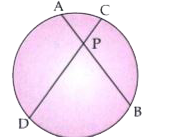
View SolutionA bag contains 5 white balls, 6 red balls and 9 green balls. A ball is drawn at random from the bag. Find the probability that the ball drawn is :
(i) a green ball.
View SolutionA bag contains 5 white balls, 6 red balls and 9 green balls. A ball is drawn at random from the bag. Find the probability that the ball drawn is :
(ii) a white or a red ball.
View SolutionA bag contains 5 white balls, 6 red balls and 9 green balls. A ball is drawn at random from the bag. Find the probability that the ball drawn is :
(iii) neither a green ball nor a white ball.
View SolutionRohit invested `9600rs` on `100rs` shares at `20rs` premium paying `8%` dividend. Rohit sold the shares when the price rose to `160rs` . He invested the proceeds (excluding dividend) in `10%` `50rs` shares at `40rs` find the
(i) original number of shares
(ii) sale proceeds
(iii) new number of shares
(iv) change in the two dividends
View SolutionRohit invested `9600rs` on `100rs` shares at `20rs` premium paying `8%` dividend. Rohit sold the shares when the price rose to `160rs` . He invested the proceeds (excluding dividend) in `10%` `50rs` shares at `40rs` find the
(i) original number of shares
(ii) sale proceeds
(iii) new number of shares
(iv) change in the two dividends
View SolutionRohit invested `9600rs` on `100rs` shares at `20rs` premium paying `8%` dividend. Rohit sold the shares when the price rose to `160rs` . He invested the proceeds (excluding dividend) in `10%` `50rs` shares at `40rs` find the
(i) original number of shares
(ii) sale proceeds
(iii) new number of shares
(iv) change in the two dividends
View SolutionRohit invested `9600rs` on `100rs` shares at `20rs` premium paying `8%` dividend. Rohit sold the shares when the price rose to `160rs` . He invested the proceeds (excluding dividend) in `10%` `50rs` shares at `40rs` find the
(i) original number of shares
(ii) sale proceeds
(iii) new number of shares
(iv) change in the two dividends
View SolutionThe horizontal distance between two tower is 120 m. The angle of elevation of the top and angle of depression of the bottom of the first tower as observed from the second tower is `30^(@)and24^(@)` respectively.

Find the height of the two towers. Give youe answer correct to 3 significant figures.
View SolutionThe weight of 50 workers is given below :

Draw an ogive of the given distribution using a graph sheet. Take 2 cm = 10 kg on one axis and 2 cm = 5 workers along the other axis. Use a graph to estimate the following the upper and lower quartiles.
View SolutionThe weight of 50 workers is given below :

Draw an ogive of the given distribution using a graph sheet. Take 2 cm = 10 kg on one axis and 2 cm = 5 workers along the other axis. Use a graph to estimate the following: if weight 95 kg and above is considered overweight find the number of workers who are overweight.
View SolutionA wholesaler buys a TV from the manufacturer for Rs 25,000. He marks the price of the TV 20% above his cost price and sells it to a retailer at a 10% discount on the marked price. If the rate of VAT is 8%, Find the :
(i) marked price.
(ii) retailer's cost price inclisive of tax.
(iii) VAT paid by the wholsaler.
View SolutionIf `A=[{:(,3,7),(,2,4):}], B=[{:(,0,2),(,5,3):}] and C=[{:(,1,-5),(,-4,6):}]` Find AB-5C.
View SolutionABC is a right angled triangle with `angleABC=90^(@)`, D is any point on AB and DE is perpendicular to AC. Prove that :
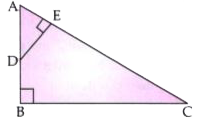
(i) `DeltaADE~DeltaACB`.
View SolutionABC is a right angled triangle with `angleABC=90^(@)`, D is any point on AB and DE is perpendicular to AC.
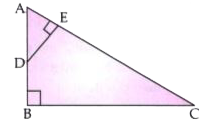
(ii) If AC = 13 cm, BC = 5 cm and AE = 4 cm. Find DE and AD.
View SolutionABC is a right angled triangle with `angleABC=90^(@)`, D is any point on AB and DE is perpendicular to AC. Prove that :
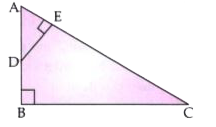
(iii) Find area of `Delta` ADE : area of quadrilateral BCED.If AC = 13 cm, BC = 5 cm and AE = 4 cm.
View SolutionSum of two natural number is 8 and the difference of their recIprocal is `2/(15)`. Find the numbers.
View SolutionGiven `(x^(3)+12x)/(6x^(2)+8)=(y^(3)+27y)/(9y^(2)+27)`. Using componendo and devidendo find x : y.
View SolutionIn a right triangle ABC, `angleB = 90^@` If AC = 5 cm, BC = 3 cm, Find AB.
View SolutionIn a right triangle ABC, `angleB = 90^@`
If AB = 6 cm, BC = 8 cm, Find AC,
View SolutionConstruct the kite EASY if AY = 8 cm, EY = 4 cm and SY = 6 cm. Which properties of the kite did you use in the process?
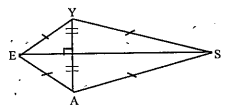
View Solution
SECTION- B questions and complete solutions for chapter MATHEMATICS- 2015 of SELINA MATHS (ENGLISH) of Class 10